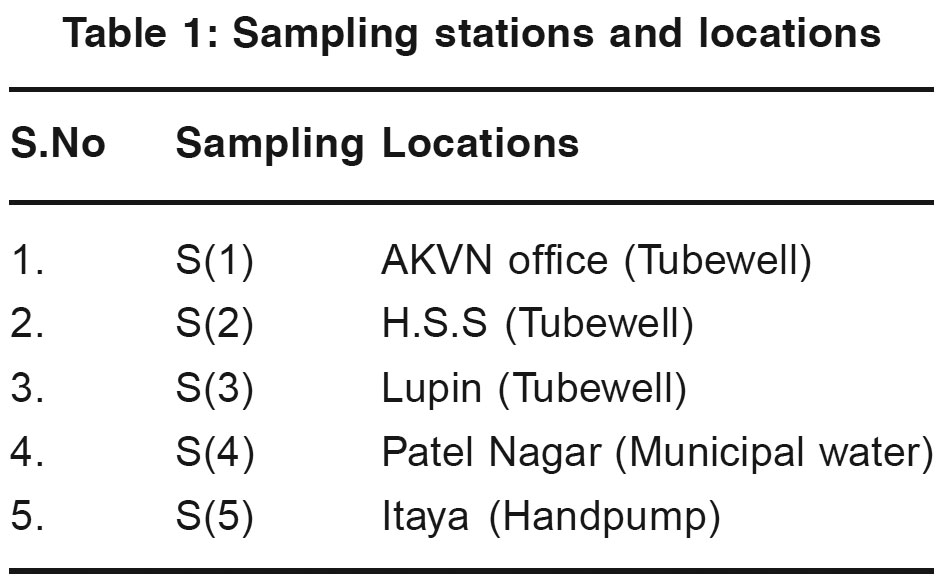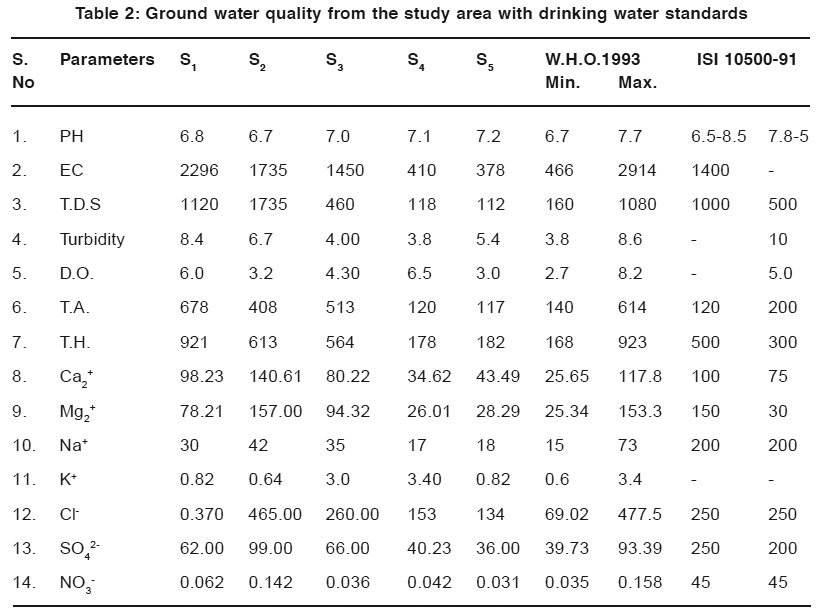Monitoring of ground water quality in Mandideep industrial area, Bhopal (India)
Ananad Sharma1 * and D.R. Tiwari1
1
Department of Chemistry,
Government M.V.M.,
Bhopal,
India
2
Department of Geology,
Government M.V.M.,
Bhopal,
India
DOI: http://dx.doi.org/10.12944/CWE.3.1.32
Ground water quality monitoring was carried out during financial year 2007. Water sample were collected from a number of hand pumps and tube wells and analysed for all relevant parameters as per standard methods APHA 1995, Results were discussed with respect to possible impact on human health.
Copy the following to cite this article:
Sharma A, Tiwari D.R. Monitoring of ground water quality in Mandideep industrial area, Bhopal (India). Curr World Environ 2008;3(1):199-202 DOI:http://dx.doi.org/10.12944/CWE.3.1.32
Copy the following to cite this URL:
Sharma A, Tiwari D.R. Monitoring of ground water quality in Mandideep industrial area, Bhopal (India). Curr World Environ 2008;3(1):199-202. Available from: http://www.cwejournal.org/?p=809
Download article (pdf)
Citation Manager
Publish History
Select type of program for download
| Endnote EndNote format (Mac & Win) | |
| Reference Manager Ris format (Win only) | |
| Procite Ris format (Win only) | |
| Medlars Format | |
| RefWorks Format RefWorks format (Mac & Win) | |
| BibTex Format BibTex format (Mac & Win) |
Article Publishing History
| Received: | 2008-03-21 |
|---|---|
| Accepted: | 2008-05-25 |
Introduction
Now a days the accelerated pace of development rapid industrilisation and population density have increased the demand of water. Ground water a gift of nature is the major source of drinking water both urban and rural India. Besides it is an important source of water for the Agriculture and industrial sector.
Today Human activities are constantly adding Industrial domestic and Agriculutral waste to ground water reservoirs at an alarming rate. The quality of water is a vital concern for man kind since it is directly linked with human welfare. It is a matter of Histroy that faecal pollution of drinking water caused water borne diseases which wiped out entire population of cities.
Study Area
Mandideep an Industrial township near Bhopal developed by A.K.V.N has over 60 medium and large size Industrial units running successfully.
It has mainly chemical electrographite dyes, plastic and rubber Industrial units. Most of these industries produce waste containing toxic heavy metals along with hazardous organic and inorganic effluents, these chemcials contaminate ground water and severely pollute it.
There are no rich aquifers in the study area and the only ground water present is perched in the aqufires and in rock cracks. Joint and cavities. The people are using bore well water as well as municipal water supply for their daily need due to acute summer there is always a shortage of water in Mandideep.
Material and Methods
The main objective of surface water quality monitoring is to assess the existing level of ground water pollution. On the basis of preliminary survey of the study area five number of sampling stations were selected at different locations.
In order to assess the ground water samples quality water samples were collected from these sampling stations during finanical year 2007. The sampling stations and locations are given in table 1.
The water sample were collected in plastic canes of 3 litre capacity as per standard procedure. The physico chemical parameters such as pH, temperature, electrical conductivity (EC), Total dissolved solids (T.D.S), Turbidily, dissolved oxygen (DO) Total alkilinity (T.A.), Total Hardness. (TH) calcium (Ca2+), Magnesium (Mg2+) Sodium (Na+), pottasium (K+), Chloride (Cl-), Sulphate, (SO42-) Nitrate (NO3-), were analysed using standard methods. (APHA 1995). Reagent used for the present investigation were A.R. grade and double distilled water was used for preparing various solutions.
 |
Table 1: Sampling stations and locations Click here to view table |
Results and Discussion
The average value of phisicochemical parameters during financial year 2007, are presented in table 2. The values obtained were compared with standard value prescribed by WHO and ISI-10500-91.
The PH values varied between 6.7 to 7.2 and were with in the presribed limit by W.H.O.
Electrical conductivity values signifies the amount of total dissolved salts. EC. values varries from 378 to 2896 µmho/cm. which reveals that EC values for all tube well samples were greater than the pescribed limit. The E.C. value for sample S4 and S5 were found within the limits.
T.D.S. values varied from 112 to 1120 mg/l. It shows that sample S1 and S2 have higher values than the prescribed limit given by ISI 10500-91.
D.O. values varied between 3.0 to 6.5. It shows that sample S1 and S4 have higher values than presribed limit given by ISI 10500-91.
In the present study the turbidity values varies between 3.8 to 8.4, N.T.U and were within the prescribed limit.
 |
Table 2: Ground water quality from the study area with drinking water standards Click here to view table |
Total alkilinty values for tubewell samples were found to be greater than the perseribed limit by ISI 10500-91.
Total hardness value for tubewell samples were found to be greter than prescribed limit by ISI 10500-91.
The amount of calcium varies from 34.26 to 110.16 and amount of Magnesium varies for from 26.01 to 137.00 which is found within the presribed limit.
Similarly Na+ and K+ contents were found below the prescribed limit.
Chloride value for tubewell samples were found to be greater than prescribed limit by ISI 10500-91.
The sulphate varies from 36.0 to 62 and Nitrate values varies from 0.031 to 0.062. The sulphate and nitrate values were found within the presecribed limit.
Conclusion
Thus, in the ground water of the study of area - E.C. total dissolved solids, total Hardness, total alkilinity and chlorides have been found exceeding the limits prescribed by ISI -10500 (1991) at sampling station S(1), S(2) and S(3). In general it may be stated that the quality of tube well water is infirior as compared to Hand pump and Municipal water. It may be due to impact of industrial and domestic effluents. These high values can be deleterious to the health of Human beings and thus corrective measures are necessary to prevent increase of Chemical parameter in ground water and to safe guard public health.
References
- APHA standard methods for the examinations of water and waste water (19th Edn.) American Public Health Association, Washington, DC, (1995).
- Indian Standard Specification for Drinking Water, ISI, New Delhi (1991).
- WHO, World Health Organisation International Standards for Drinking Water, Geneva, Swizerland (1993).
- Mancy, K.H., "Analytical problems in Water Pollution Controls" in Analytical Chemistry: Key to progress National Problems, NBS Special Publication 351, Washington DC,USA August (1972) p. 297-382.
- Marr, I.L. and Cresser, M.S., Environmental Chemical Analysis, International Textbook co. Glasgow (1983).
- D.F.S. Natusch and P.K.Hopke, Analytical Aspects of Environmental Chemistry, John Wiley & Sons, New York (1983).
- NEERI., Mannual on water and Waste Water Analysis, National Environmental Research Institute, Nagpur (1986).
- Holden, W.S. Water Treatment and Examination Church Hill London pp. (1970) 513.
- ICMR., Mannual Standards of Water Quality for Drinking Water Supplies, 2nd Edition, Indian Council of Medicinal Research, New Delhi (1973) 21.






